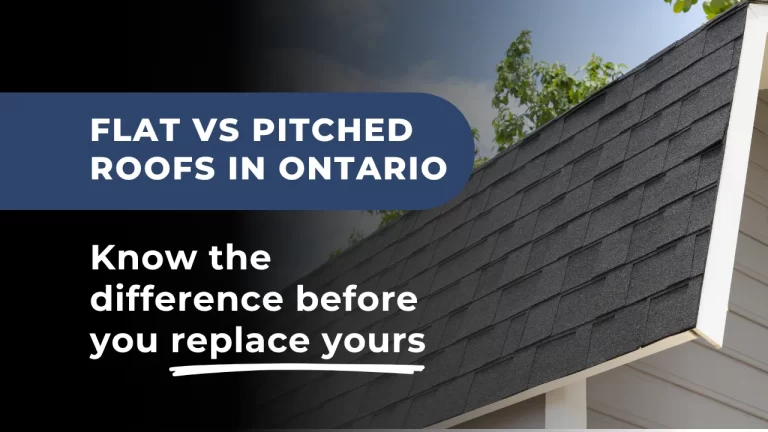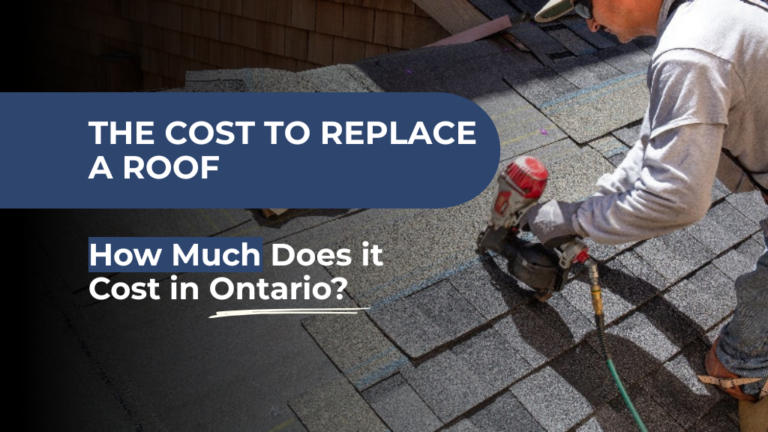What type of roof is best suited for your home?
If you’re planning a roof upgrade or tackling a major renovation, you might find yourself asking: should we go flat or pitched? It’s a fair question. The answer depends on more than looks, especially in Ontario. Snow loads, seasonal drainage, long-term maintenance, and even resale value all play a role.
At Gateway, we install pitched roofing systems for residential homes. We don’t install pitched roofs by preference, we install them because they’re built to handle Ontario’s climate and deliver the long-term performance homeowners expect. Explore our residential roofing services to see what that looks like in practice: materials, code alignment, and clean installs that last.

Flat vs pitched roofs: pros and cons
A flat roof isn’t completely flat. It typically has a very slight slope (around 1–10 degrees) to allow for drainage. You’ll find these mostly on commercial buildings, modernist homes, and some urban additions. They often use rubber, membrane, or TPO roofing systems that are sealed and layered.
Pitched roofs, by contrast, have visible angles that slope down from a peak. These systems use layered shingles, ventilation pathways, and structured framing to move water quickly and protect against snow accumulation. Materials vary, but architectural asphalt shingles remain one of the best roof shingles in Canada for residential use.

Flat roofs:
- Appear sleek and modern
- Can be used as rooftop patios or solar panel bases
- Require specialized drainage and membrane maintenance
- Common materials: EPDM, TPO, and modified bitumen membranes
- Maintenance needs: Regular inspections for pooling, membrane separation, and flashing wear (flat roof maintenance issues)
Pitched roofs:
- Shed water and snow more efficiently
- Provide attic space and ventilation benefits
- Are easier to inspect and repair
- Common materials: Architectural asphalt shingles, metal flashing, synthetic underlayment
- Maintenance needs: Occasional shingle replacement, attic airflow checks, seasonal eaves cleaning

Why the difference between flat vs pitched roofs matters in Ontario
Ontario winters are no joke. Heavy snow, ice buildup, and freeze-thaw cycles can overwhelm a poorly designed roof. Pitched systems shine here because they promote water runoff and prevent ice dams from forming at the eaves.
Flat roofs, while structurally viable, can collect snow and water if not properly maintained. This increases the chance of leaks, ponding, and insulation breakdown, especially during spring.

If you live in places like Hamilton or Binbrook, you’ve likely seen neighbours struggle with flat roof drainage issues during March and April. That meltwater has nowhere to go unless the membrane system is actively maintained.
Pitched roofs also:
- Offer a longer lifespan with fewer major repairs
- Are better suited to layered insulation and proper ventilation
- Tend to meet local building codes more easily for sloped residential properties
Common misconceptions about roof types
“Flat roofs are cheaper.”
Flat roofs may have lower upfront labour costs due to simpler framing, but maintenance costs can creep up. Membrane repairs, drain blockages, and lifespan issues often mean more long-term spending.
According to Green Building Canada, replacing a flat roof in Ontario generally ranges from $5 to $17 per square foot, depending on roof size, materials, and labour. Costs that add up quickly for larger homes or aging membranes. You can learn more about how these expenses compare across styles on our roof replacement cost breakdown page.

“Flat means modern and efficient.”
Modern style is subjective. And efficiency depends on design, not just the shape. Pitched roofs often support better insulation and airflow, especially in older homes.
“Pitched roofs are always more expensive.”
Complexity and materials both play a role. For most Ontario homes, pitched roof systems are more accessible, code-compliant, and cost-effective over time.
Pitched roof benefits in real-world scenarios
Still unsure? Here are a few common situations where homeowners are deciding between options:
Scenario 1: The leaky addition
You added a flat-roofed rear addition five years ago. Now it pools every spring. Patching helps for a bit, but the ceiling stains keep coming back. In this case, switching to a pitched roof with proper venting could save major repair costs.
Scenario 2: Renovating to sell
You’re upgrading your exterior before listing your home. A pitched roof can enhance curb appeal, check the box for buyers, and reduce inspection-day stress.
Scenario 3: Managing a duplex
As a landlord, you’re tired of repeat service calls on your flat-roof duplex. A pitched system might mean a bigger upfront cost, but fewer seasonal issues and lower tenant complaints.
Gateway scopes each roofing project with these factors in mind. We’ll walk the property, explain your options, and make sure you understand the difference between flat vs pitched roofs so you can make the right decision for your home.
Explore your residential roofing options
Whether you’re replacing an old roof or planning an upgrade, knowing the difference between flat vs pitched roofs helps you make the right call for your home.
At Gateway, we install pitched residential roofs designed to handle Ontario’s weather and built to last through the seasons. Every detail matters, whether it’s attic ventilation, underlayment, or the final shingle.
Flat vs pitched roofs FAQs
Can I replace a flat roof with a pitched one?
Yes, in some cases. It depends on your home’s structure, local zoning regulations, and the space around the roofline. Gateway can assess feasibility during a site inspection.
Do pitched roofs last longer than flat roofs?
In most cases, yes. Pitched roofs with asphalt shingles can last 25–50 years with proper care. Flat roofs often need major work or full replacement every 15–25 years.
Flat vs pitched roofs: which is better for a home in Ontario?
It can be, for the right project. Flat roofs can work on modern homes or smaller structures, but they demand consistent upkeep and aren’t always the best long-term fit for heavy snow zones.





